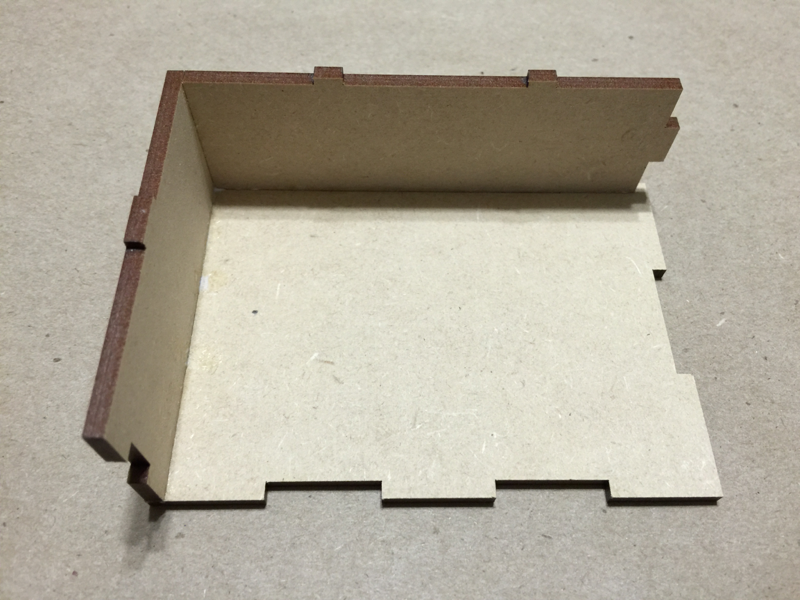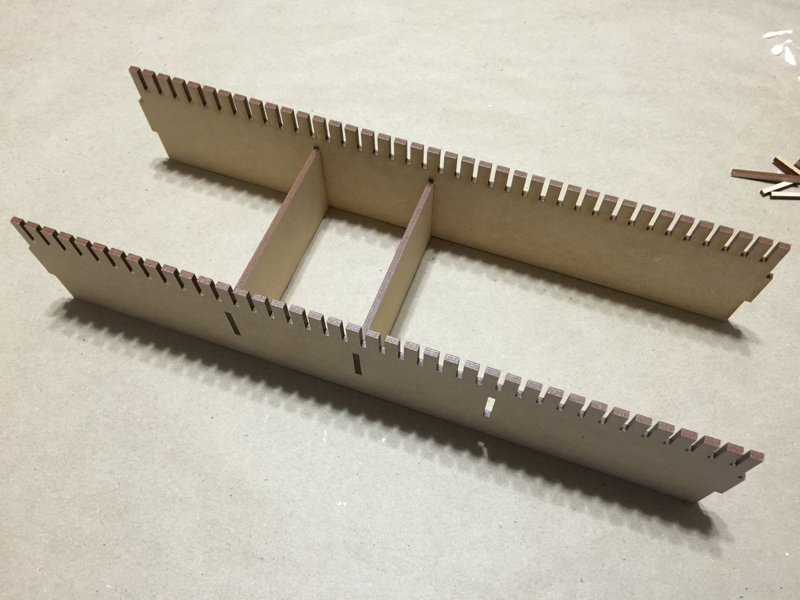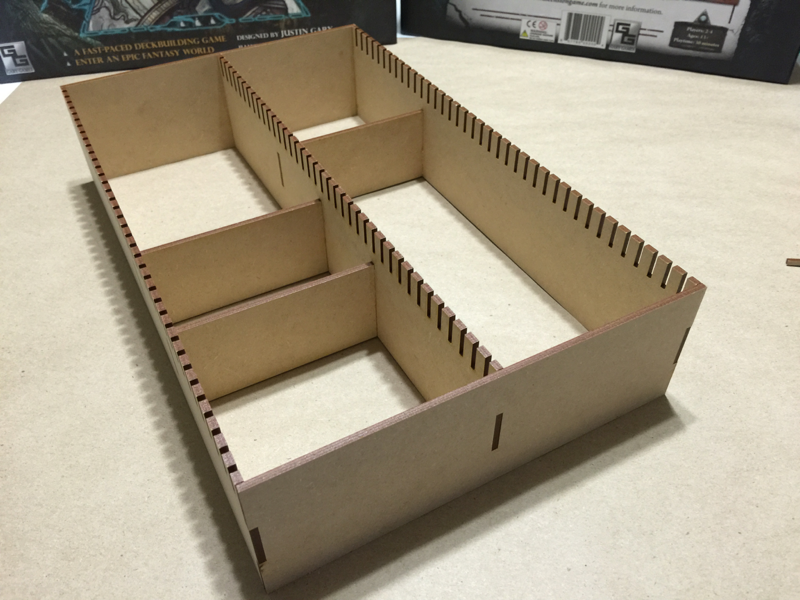Congratulations on your purchase of our insert for Ascension! Construction is relatively easy and only requires about 30 minutes.
HDF

Our inserts are almost always cut using a NAF HDF. The HDF we use is formed using a special resin that results in a wood product that is impregnated with polyurethane. This makes the resulting wood heavier than normal HDF, but this HDF contains no added formaldehyde, unlike 99% of the HDF available in the U.S. market. HDF is constructed from tiny wood bits (essentially sawdust) mixed with a resin, and then heat pressed. This results in a very uniform wood sheet that is smooth on both sides and contains no knots or patches. Cutting HDF on the laser is like cutting butter with a warm knife. It is the ideal material to cut! However, keep in mind that all wood sheet products of this type do experience some color variation. This typically manifests as slightly darker splotches a millimeter or two in size here and there on the surface of the wood. This is normal.
Glue & Painter’s Tape (Blue)

Everyone has a favorite glue. Mine is Sobo Craft Glue. When building our inserts, you want a thick, tacky white glue that sets quickly and dries clear, allowing you to continue building and not hold pieces while waiting for them to bond together. You don’t have to use Sobo, but you should use a tacky glue if possible. It will make the experience almost effortless. Also, we ship our inserts with the small bits of wood still present in the finger joint cutouts and you should use the longer sticks to assist with glue cleanup as you build your insert.
While a tacky glue makes construction easy, some blue painter’s tape will really help with the corner joins. You can just hold the pieces together for 30 seconds to a couple of minutes, but painter’s tape will do the job for you and a roll can purchased for just a few dollars in any home improvement store. Painter’s tape is ideal because the adhesive used is strong, but not too strong. Stronger adhesives can damage wood surfaces or leave adhesive behind.
Work Area
A good work area will make your construction project quick and orderly. You don’t need much space – maybe a 24″x 24″ area. I like to lay some printer paper down on my work surface and I place an extra piece of paper to the side to act as a glue collection area as I use the glue sticks to clean up my joints.
Sanding
You have the option of sanding the pieces of your new insert. We cut our inserts using a custom lamella arrangement to reduce laser flashback on the lower surface of the wood, and we use a nose cone that provides low-pressure air assist to reduce the amount of “browning” around the cuts, but some browning and flashback are unavoidable. If you do choose to sand the pieces, use a 320 grit sandpaper and hand sand the pieces. A very light sanding will remove any “browning.”
Painting/Finishing
We don’t recommend that you paint or finish your insert as this may interfere with the placement of the dividers. They are sized to fit snugly in the lanes of your new insert. The addition of paint will likely make it very hard to place them properly. Staining will generally work great, but may require that you then sand your pieces a bit. If you decide to stain, I would recommend you stain both sides of each frame, allow to dry, lightly sand as needed, and then remove the pieces from the frames. Finishing in polyurethane is very tricky with inserts that have divider slots. The polyurethane can get into those divider slots and cause problems.
Handle with Care
You should always use care when punching your pieces out of the frames. This is especially important when punching lane rails that have many slots for dividers. The HDF is tough, but applying a large amount of force is not recommended. Use a front and back punching motion to free pieces from the frame. Our inserts are designed to be punched from the containing frames without the use of a knife to assist.
Dry Fitting
Before you start glueing things, you should layout the pieces and dry fit them so you have a good understanding of how they go together. This is Golden Rule #1. This will help you avoid mistakes such as glueing the wrong side of a piece. Once you dry fit your insert, you can lay the pieces out in their approximate positions as a reminder of what goes where. It helps! When we produce an insert, we produce the entire box from the same sheet of wood to ensure that color and finish match.
The very first thing you should do is grab the base of the insert, remove it from the frame, and ensure it fits in your box. While the laser is very precise, manufacturers do change box size sometimes. If you find your base doesn’t fit into your box, let us know by using the contact form.
Constructing the Trays
Your insert provides two (2) bit trays to store the player bits in a stacked, lidded configuration. Let’s build the trays and then set them aside to dry.
First, do a quick dry fit to ensure you understand how the bottom tray goes together. You can set aside the parts for the other tray for now. Once you have built the first one, you will build the other.

Now that you know how the tray goes together, let’s get to building. Place some glue on the bottom tabs of a short side for the tray and then place the piece and cleanup excess glue (this part is always assumed once you place a piece.)


Next, place glue on one of the long sides of the tray and place it.

Next, place glue on the other short side of the tray and place it.
 Finally, put glue on the final long side and place the side, completing the tray.
Finally, put glue on the final long side and place the side, completing the tray.

Now, construct the smaller tray using the same instructions.

Once the smaller tray had a few minutes to dry, you can stack the trays and then carefully place the engraved lid on top.

Now you can set your trays aside to dry.
Remove the Remaining Pieces from the Frames

Next, punch out the pieces for the main insert from the remaining frames.
Build the Main Insert
First, layout the middle rail and the right outer wall rails, as well as two structural dividers. Don’t forget to dry fit the pieces so you understand how they go together.

Next, apply glue to the right side of one of the structural dividers

and attach it using the rear hole of the right outer wall.

Next, apply glue to the right side of the other structural divider and attach it using the other hole on the right outer wall.

Now apply glue to the other side of each of the structural dividers

and connect the center rail.

Next, glue one side of the remaining structural dividers

and connect it to the other side of the center rail.

Now carefully glue the other side of the structural divider

and connect the left outer wall.

Next, glue the ends of the rails

and connect the front wall.

Next, apply glue to the ends of the rails on the other side of the insert

and connect the final wall.

Your insert is complete!
Placing the Insert
You should let your insert dry overnight and once dry, drop it into the box and fill it up!
If the insert is obviously larger than the box, don’t force it as this will split the corners of the box. Our inserts are designed to fit snugly into various manufacturer’s boxes, but sometimes a manufacturer may change the box design. Be mindful of this possibility.
Sometimes, the printed paper that wraps around from the outside of the box and into the inside of the box will provide resistance. Gentle, but firm pressure applied to each side of the insert, in turn, will slowly slide your new insert into the box.


